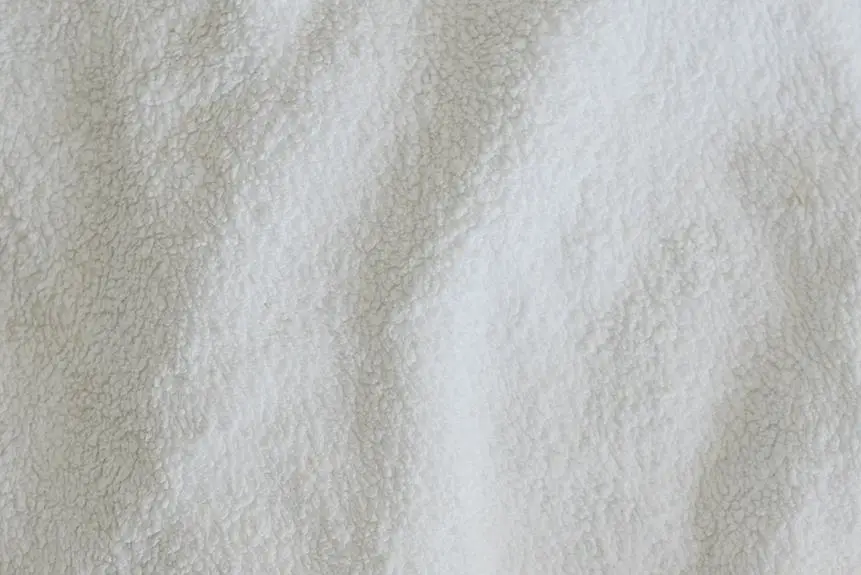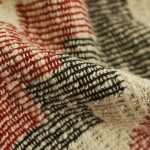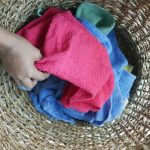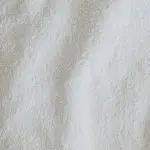Ever wondered if terry cloth is really made of cotton? Let's dive into the truth behind this popular fabric.
Terry cloth has been a staple in the world of textiles, known for its absorbency and softness. Understanding the composition of terry cloth is essential for mastering its properties and applications.
So, let's explore the origins of terry cloth, unravel the myth surrounding its connection to cotton, and delve into the various types and uses of this versatile fabric.
By the end, you'll have a clear understanding of whether terry cloth is indeed made of cotton and the implications of its composition.
Key Takeaways
- Terry cloth is primarily made from cotton, but can also be blended with polyester, bamboo fibers, or microfiber materials.
- The looped pile structure and long cotton fibers contribute to its absorbency and softness.
- Different types of terry cloth include Zero Twist Terry Cloth, Velour Terry Cloth, French Terry Cloth, Terry Velour, and Terry Knit.
- Terry cloth is used in various products such as towels, bathrobes, sportswear, spa accessories, and baby products.
The Origins of Terry Cloth
Terry cloth, as we know it today, has its origins in the early 19th century when it was first woven in England for use as towels and robes. The evolution of terry cloth is quite fascinating. Originally, it was solely made from pure linen. However, as time went on, cotton became the primary material due to its superior absorbency and softness. This shift marked a significant turning point in the history of terry cloth, as it greatly enhanced its functionality and comfort.
The historical significance of terry cloth can't be overstated. Its introduction revolutionized the textile industry, providing a more efficient and comfortable option for towels and robes. The absorbent loops that characterize terry cloth allowed for better moisture absorption, making it ideal for various purposes. Over time, this fabric has become synonymous with luxury and relaxation, often associated with spa experiences and high-quality bath linens.
Understanding the origins and evolution of terry cloth sheds light on its enduring popularity and widespread use in modern times. It's a testament to the enduring appeal of this fabric that has stood the test of time.
Understanding Terry Cloth Composition
To understand the composition of terry cloth, examine the fibers used in its production. Terry cloth is primarily made from cotton, but it can also incorporate other materials to enhance its properties. Here's what you need to know about terry cloth composition:
- Cotton: Terry cloth is traditionally made from cotton, known for its absorbency, softness, and durability. The loops and pile of terry cloth are formed from cotton yarns, creating the fabric's characteristic plush texture.
- Polyester: In terry cloth manufacturing, polyester is sometimes blended with cotton to improve the fabric's strength and resistance to wrinkling. This blend can also enhance the fabric's ability to retain its shape and color after repeated washing.
- Bamboo: Some terry cloth products use bamboo fibers, which are prized for their natural antibacterial properties and exceptional absorbency. Bamboo-derived terry cloth is known for its eco-friendly and sustainable characteristics.
- Microfiber: For specialized applications, terry cloth may contain microfiber materials. Microfiber terry cloth offers superior cleaning and polishing properties, making it ideal for towels and cleaning cloths.
Understanding the composition of terry cloth provides insight into its performance and care requirements, as well as the diverse options available in the market.
Unraveling the Myth: Cotton and Terry Cloth
While cotton is the primary fiber used in terry cloth production, there are misconceptions about its exclusive composition. Terry cloth is not solely made of cotton; it is a woven fabric with loops that can be made from various fibers. Let's delve deeper into the fabric composition of terry cloth to unravel this myth.
| Fiber Type | Characteristics | Common Usage |
|---|---|---|
| Cotton | Soft, absorbent, breathable | Towels, bathrobes, washcloths |
| Bamboo | Naturally antibacterial | Sustainable towels, bathrobes |
| Microfiber | Quick-drying, durable | Sports towels, cleaning cloths |
| Hemp | Strong, eco-friendly | Bath towels, spa wraps |
As seen in the table, terry cloth can also be crafted from bamboo, microfiber, and hemp, among other fibers. Each fiber brings unique characteristics to the fabric, expanding its utility beyond traditional cotton-based products. Understanding this fabric composition dispels the misconception that terry cloth is exclusively cotton-based. Whether it's for luxuriously soft towels or sustainable bathrobes, knowing the fabric composition allows you to make informed choices based on your preferences and needs.
Properties of Terry Cloth
Terry cloth is known for its absorbent and soft qualities, making it a popular choice for towels and bathrobes. The looped pile texture of terry cloth adds to its absorbency, allowing it to quickly soak up moisture.
These properties make terry cloth a practical and comfortable fabric for various household and personal items.
Absorbent and Soft
When using terry cloth, you'll notice how it quickly absorbs water and feels exceptionally soft against your skin. These properties are a result of its unique fabric construction and towel manufacturing process. Here's why terry cloth is absorbent and soft:
- Looped Pile Structure: The looped pile construction of terry cloth creates a larger surface area, allowing it to efficiently absorb moisture.
- Long Cotton Fibers: Terry cloth is typically made of long-staple cotton fibers, which contribute to its softness and absorbency.
- Twisting Technique: During towel manufacturing, the twisting technique used on terry cloth fibers enhances their absorbent properties.
- Quality Weaving: The weaving process of terry cloth ensures a balance between absorbency and softness, making it a popular choice for towels and bathrobes.
These factors combine to make terry cloth an ideal choice for products designed to be absorbent and gentle on the skin.
Looped Pile Texture
You'll find that the looped pile texture of terry cloth contributes to its exceptional absorbency and softness. This unique texture is achieved through fabric engineering and plays a crucial role in towel manufacturing.
The loops in the terry cloth create extra surface area, allowing for increased absorption of moisture. When you use a terry cloth towel, these loops work like tiny sponges, quickly soaking up water.
Additionally, the loops provide a gentle and plush feel, making the fabric incredibly soft against your skin. This is why terry cloth towels are so highly favored for their ability to efficiently dry the body while providing a luxurious experience.
The looped pile texture is a prime example of how fabric engineering can enhance the functionality and comfort of everyday textiles.
Different Types of Terry Cloth
When exploring terry cloth, you'll find different types that vary in texture and absorbency. Each type has unique characteristics that make it suitable for specific purposes. Here are four common types of terry cloth:
- Zero Twist Terry Cloth: This type is made from long, silky fibers that aren't twisted during the manufacturing process. As a result, zero twist terry cloth is incredibly soft, highly absorbent, and quick-drying, making it ideal for luxurious towels and bathrobes.
- Velour Terry Cloth: Velour terry cloth has a smooth and silky feel on one side, achieved by shearing the loops on one side of the fabric. This type is often used for making bathrobes, spa wraps, and beach towels due to its plush and luxurious texture.
- French Terry Cloth: With flat loops on one side and the characteristic terry texture on the other, French terry cloth is both absorbent and moisture-wicking. It's commonly used in sportswear, casual clothing, and baby products.
- Organic Terry Cloth: This type is made from organic cotton, free from synthetic pesticides and fertilizers. It's environmentally friendly, soft, and gentle on the skin, making it perfect for baby products, towels, and bathrobes.
Uses and Applications of Terry Cloth
Terry cloth finds widespread use in various products such as towels, bathrobes, and sportswear due to its high absorbency and soft texture. The softness and durability of terry cloth make it an ideal choice for items that require frequent use and washing. Its ability to absorb moisture makes it perfect for bath towels and robes, providing a comfortable and luxurious experience after a shower or bath. The durability of terry cloth also makes it suitable for sportswear, as it can withstand the rigors of physical activity and frequent laundering.
In addition to towels, bathrobes, and sportswear, terry cloth is also used in various other applications such as spa accessories, cleaning cloths, and baby products. Its versatility and ability to maintain its softness and absorbency make it a popular choice for a wide range of items. When it comes to maintenance, terry cloth is relatively easy to care for, as it can typically be machine washed and dried. Its durability ensures that it can withstand regular washing without losing its softness or absorbent qualities, making it a practical and reliable choice for everyday use.
Pros and Cons of Terry Cloth
While terry cloth offers high absorbency and durability, it's important to consider its potential drawbacks as well.
- Durability and Maintenance: Terry cloth is known for its durability, making it a long-lasting choice for various applications. However, it requires proper maintenance to retain its quality. Frequent washing and drying can cause the fabric to lose its softness and absorbency over time.
- High Absorbency: One of the main advantages of terry cloth is its exceptional absorbency, making it ideal for towels, bathrobes, and cleaning cloths. On the downside, its high absorbency can also make it prone to retaining moisture and taking longer to dry, leading to potential musty odors and mildew if not properly cared for.
- Comfort and Softness: Terry cloth is renowned for its soft and comfortable texture, providing a luxurious feel. However, some individuals may find the looped pile texture to be too rough or irritating on the skin.
- Eco-friendly Alternatives: While terry cloth is often made from cotton, which is a natural and biodegradable material, it can also be produced using synthetic fibers. Opting for eco-friendly alternatives, such as organic cotton or bamboo terry cloth, can address environmental concerns and offer sustainable options for consumers.
Caring for Terry Cloth Products
To maintain the durability and absorbency of terry cloth products, it's essential to follow proper care guidelines to prevent loss of softness and potential musty odors.
When it comes to terry cloth maintenance, washing tips are crucial. Always wash terry cloth items separately from other fabrics to prevent lint transfer and maintain their fluffy texture. Use a gentle detergent, as harsh chemicals can break down the fibers and reduce absorbency. Avoid using fabric softeners, as they can create a coating that hinders the cloth's ability to absorb moisture effectively.
Additionally, it's best to wash terry cloth items in warm water to ensure thorough cleaning without damaging the fabric. After washing, tumble dry on a low heat setting or air dry to maintain the integrity of the fibers. Be sure to shake out the items before placing them in the dryer to fluff the loops.
Following these washing tips will help prolong the softness, absorbency, and overall quality of your terry cloth products.
Frequently Asked Questions
Can Terry Cloth Be Made From Materials Other Than Cotton?
Yes, terry cloth can be made from materials other than cotton. Synthetic materials like polyester and microfiber are used as terry cloth alternatives. They offer different textures and performance characteristics compared to traditional cotton terry cloth.
Is Terry Cloth Suitable for Use in Hot and Humid Climates?
In hot and humid climates, terry cloth is great for moisture absorption and breathability, keeping you comfortable. Its heat retention properties are minimal, making it suitable for warm weather, making it a good choice for your needs.
What Are the Environmental Impacts of Terry Cloth Production?
When it comes to the environmental impacts of terry cloth production, the water consumption and pollution, energy usage, and waste management are important factors to consider. The production process can have significant effects on the environment.
Can Terry Cloth Products Be Used for Outdoor Activities Such as Camping or Hiking?
When it comes to outdoor activities like camping or hiking, terry cloth is a great choice. Its durability makes it perfect for rugged use, and its moisture-wicking properties keep you comfortable during your adventures.
Are There Any Special Considerations for Caring for Terry Cloth Products Made From Organic Cotton?
When caring for terry cloth products made from organic cotton, remember the benefits of its absorbency and softness. Wash in warm water and avoid using fabric softeners to maintain its quality and eco-friendly properties.
- Does Chiffon Fabric Stink - July 15, 2025
- Does Chiffon Fabric Affect the Economy - July 15, 2025
- Does Cotton Fabric Have a Nap - July 15, 2025







